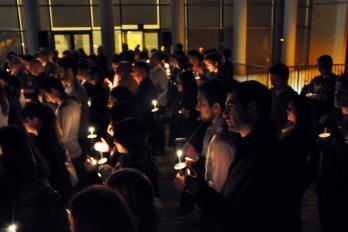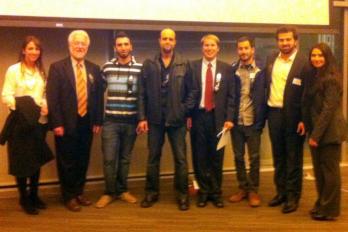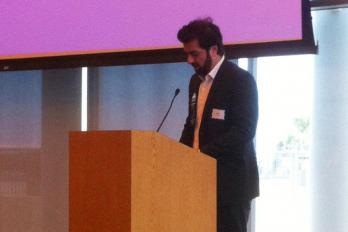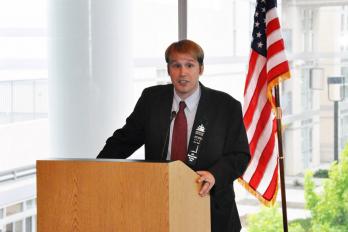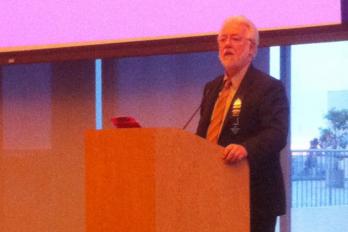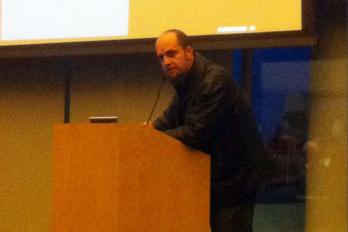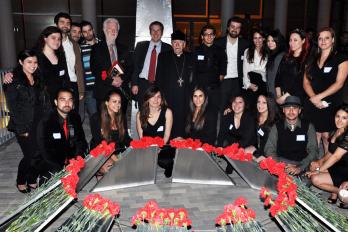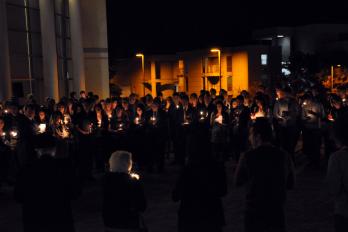TJSL Professors Stand Up For What’s Right
April 30, 2012
By Vartkes Artinian, 3L (Photos by Gevork Shaginian)
For most people, April 24 is just another day, but for various Armenian communities around the world it is a day of remembrance for the 1.5 million brothers and sisters who had fallen victim to brutal genocide during the turbulent decades surrounding World War I.
This past Tuesday, April 24, 2012, Thomas Jefferson School of Law Professors Chris Guzelian and William Slomanson presented at this year’s Armenian Genocide Commemoration event at the University of California, San Diego. The event was sponsored by various organizations within the San Diego Armenian Community, including the UC San Diego Armenian Students Association and our very own TJSL Armenian Law Students Association.
The keynote speaker was renowned filmmaker and director Roger Kupelian, who has worked on such movies as the Lord of the Rings Trilogy, Shutter Island, Moneyball, X-Men: First Class, and more. He is currently negotiating a deal with Mel Gibson and his production company on a project that tells the story of the Armenian “Braveheart,” that of General Vartan Mamikonian, who in 451 A.D., led 66,000 freedom loving Armenians into battle against 300,000 Persians (including the “Immortals”) in an effort to discourage Persian influence, dominion, and control over their lands. Facing certain death, Mamikonian’s story mirrored closely to that of the famed Spartan 300, a martyr’s death that helped preserve Armenian culture and identity.
At the commemoration, Mr. Kupelian spoke about the differences between warriors and thugs. He paralleled them with the brutal massacres that took place within the Ottoman Empire, when Turkish soldiers took their orders to relocate the Armenian population to more sadistic and thuggish extremes: raping, torturing, or taking bets on the gender of unborn babies before slicing open their mother’s stomachs to see who won. Mr. Kupelian explained that trauma like this exists within the genetic memory of many cultures, because genocides continue to occur even today. However, he explained that it is the responsibility of that culture to not let anger and remorse take over. At that point, Mr. Kupelian began showcasing his own personal art, presenting short films that take the pain of the past and transform it into the positive. Creativity and beauty was quickly revealed as the main theme in his lecture, and it goes without saying that it was a necessary shot in the arm for all those who partook.
Professor Guzelian, the master of ceremonies for the event, presented a touching slideshow documenting his travels through the current Republic of Armenia as well as territories currently within Turkey. The theme of his slideshow was brotherhood; finding both Turks and Armenians living together within Turkey in prosperity. He expressed, “The event was a resoundingly well-received and well-attended success in informing the San Diego community about the historical events of the 1915 Armenian Genocide.”
Professor Slomanson provided a masterful perspective on the legal significance of the word “genocide” in international law. The audience was also greatly benefitted by Roger Kupelian’s description of ongoing material deprivation and cultural genocide that Armenians throughout the Caucuses region, most obviously in Nagorno-Karabagh, are suffering as a result of blockades and embargoes by neighboring countries.”
Professor Slomanson spoke on the topic of genocide within the contexts of the legal community. “I am going to the South Caucuses this summer, to enhance my specialty involving unilateral secessions—including Nagorno Karabakh. I was most honored, and incredibly fortunate, to have been welcomed into the local Armenian Diaspora via my participation in the 97th commemoration of the Armenian Genocide. This new horizon, opened for me by Professor Guzelian, will greatly enhance multiple features of my fall International Law class.”
Armenian Law Students Association graduating board member Eric Shakelian was present at the commemoration and said, “[t]he commemoration was a great way to stay in touch with our cultural heritage amidst the busy schedule of law school. In celebrating the lives of our ancestors and honoring their struggles, the annual commemoration keeps us grounded and mindful of our unique culture.”
Christine Tornatore, also a graduating 3L and vice-president on the ALSA board, attended the commemoration and expressed, “This was a great event to give awareness to current genocides and pay respect to those affected by the Armenian Genocide, and it was also a great opportunity to connect with the San Diego Armenian community.”
There was a time when the Turkish Ottoman Empire drew strength from its diversity; when tolerance for different cultures and religions were absolute. However, things had changed as the empire aged and approached the 20th century. The Ottoman government had declared jihad against England, France, and Russia. World War was breaking out. Demands were made to Armenians, Assyrians, and Greeks to peacefully relinquish any weapons in their possession, even kitchen knives. Armenian intellectuals were invited to meetings only to be arrested, taken away, and never heard from again. Cities and villages were culled. Tens of thousands of Armenians were raped, tortured, and forced to march miles on end to one of 36 extermination centers within their region. Tolerance was no longer important and 1.5 million Armenian voices were brutally silenced. This tragedy will not be easily forgiven, but it is reassuring to know that there are those strong enough to be honorable when dealing with thugs. It is a breath of fresh air to see these people take painful ugliness and recreate it into beautiful art.
Be warriors, not thugs.
